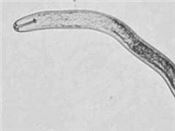|
New Method Provides A Tool To Develop Nematode-Resistant Soybean Varieties

URBANA, ILL.
Soybean cyst nematode is the number one soybean pest worldwide, accounting for estimated annual losses of nearly $1.3 billion in the United States. Some soybean varieties have resistance to the tiny parasitic worms through conventional breeding of naturally occurring resistance genes, but the current level of resistance is becoming less reliable.
“Our interest is in finding new sources of resistance, because the sources that people have been using are breaking down. Nematodes are becoming better at overcoming the resistance we have in current cultivars. We are also, interested in improving our understanding of how this resistance works so we can do a better job of selecting for it,” says University of Illinois plant breeder, Brian Diers.
In 2012, U of I geneticist Matthew Hudson, Diers, and Andrew Bent, a collaborator at the University of Wisconsin, discovered the naturally occurring genetic locus (region on a chromosome) that is critical in controlling resistance to soybean cyst nematode, but that was only the beginning.
“It turns out that at this locus, there’s a repeat of four genes,” Diers explains. “Different diverse soybean types that are resistant have different numbers of repeats. For example, in PI 88788, which is the original source of SCN resistance for most soybean varieties in the Midwest, there are nine repeats of those four genes. In the susceptible varieties, there’s only one copy of those four genes. Another source of resistance, Peking, has three copies of those repeats.”
This difference in repeat number is known as copy number variation, and is more common than previously thought. But before now, there was no easy or cost-effective way to quantify the number of gene repeats. Using a method recently developed in Hudson’s laboratory, the number of gene repeats can be accurately monitored by measuring the ratio between two genes.
Although the researchers suspected that having more copies of the gene sequence might confer a greater degree of resistance, they had no way of testing their suspicions before the new assay was developed. After getting the new assay, the team set to work again.
“We grew soybean plants in a greenhouse, inoculated them with nematodes, and then used the assay to determine how many repeats each plant had. As predicted, we found that the more repeats a plant had, the more resistant it was,” Diers explained. “This proved that the number of repeats is important.”
Armed with this information, the researchers plan to look at the number of repeats present in existing nematode-resistant soybean varieties in an attempt to explain why some display better resistance than others in field settings. They also plan to improve breeding programs by ensuring parental lines have the maximum number of repeats available in a given genotype, and to select for new variants with additional copies that may show superior resistance.
“Ultimately,” Diers adds, “if we can select for more copies, that could benefit farmers because we could get stronger resistance. Breeders will now have better tools to select for and verify resistance.”
The research described here is published in two articles. “An efficient method for measuring copy number variation applied to improvement of nematode resistance” is published in The Plant Journal. Lead author Tong Geon Lee is now at the University of Florida. Diers and Hudson, from U of I, are co-authors. “Impact of Rhg1 copy number, type, and interaction with Rhg4 on resistance to Heterodera glycines in soybean” is published in Theoretical and Applied Genetics. Lead author Neil Yu is now at Monsanto, and co-author Daniele Rosa is at the Federal University of Vicosa, Brazil. Lee, Hudson, and Diers are additional co-authors. Both studies were supported by the United Soybean Board. ∆
|
|